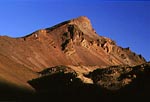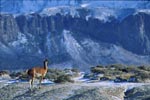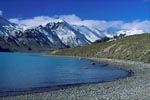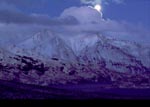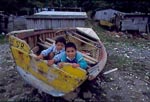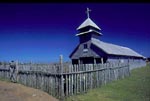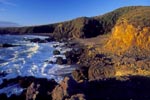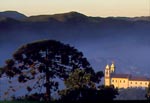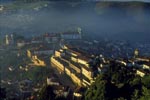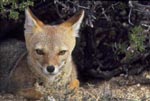
Algunas notas disponibles |

Some available articles
|
Payunia
INFIERNO
EN LA TIERRA
Cuajada de hornallas apagadas, coladas
basálticas, escorias de formas fantásticas,
campos de bombas y negra ceniza, la Payunia -una singularísima
región del centro-oeste de la Argentina- es el campo
volcánico de mayor extensión y densidad de América,
y tiene grandes chances de quedarse con el título planetario.
Además, encierra rarezas como los únicos yardangs
(formas de erosión eólica) labrados en rocas
volcánicas que se conocen fuera del planeta Marte.
Y su fauna brinda un multitudinario “show”, que
recuerda al de las planicies africanas. No extraña
que se impulse su incorporación al Patrimonio Mundial.
Fotos
disponibles: 60
|
Payunia
HELL ON EARTH
Brimming with slaked ovens, basaltic bleaches, amazingly-shaped
scoria and black ashes fields, the Payunia -a most peculiar
mid-west Argentina region- is the volcanic field with the
largest extension and density of America, and has great chances
of obtaining the world title.
Besides, it holds curiosities such as the unique yardangs
(forms
of wind erosion) carved in volcanic rock which are known out
of Mars. Moreover, its fauna gives a massive “show”,
which reminds us of the one in the African plains. Not surprisingly,
its addition to the World Heritage is promoted.
Available photos: 60
|
|
Del Volga al Paraná
LOS ALEMANES ERRANTES
Un
engaño providencial los trajo de la estepa rusa a las
suaves lomadas de la provincia de Entre Ríos, en el
flanco oriental de la Argentina. Allí cultivaron la
tierra, reprodujeron las
aldeas e iglesias que habían dejado atrás, desgranaron
con nostalgia polcas y chotis. Pero terminaron cambiando el
samovar por la bombilla y el mate. Su fe y su laboriosidad
sobreviven hoy en una comarca salpicada de cultivos y pueblitos
pintorescos, y en una cuarta parte de la población
provincial. Los Alemanes del Volga han escrito uno de los
capítulos más cautivantes de la historia de
la inmigración en la Argentina.
Fotos
disponibles: 40
|
From Volga to Paraná River
THE ERRANT GERMANS
Brought from the Russian steppes to the soft hills
of Entre Ríos province by a providential hoax, they
settled down on the east side of Argentina. There they tilled
the earth, reproduced the villages and churches they had left
behind and nostalgically played polkas and
chotis. But they turned out changing the samovar for
the Argentine mate. Their faith and workmanship still survive
in a crop-sprinkled shire and some picturesque towns, and
in a quarter of the province population. The Germans from
the Volga have written one of the most gripping chapters in
the history of immigration in Argentina.
Available photos: 40
|
|
Parque Nacional
Perito Moreno
PARAÍSO SECRETO
Lagos turquesa, guanacos de insólita mansedumbre,
troncos petrificados y las huellas de diez mil años
de historia, otorgan al Parque Nacional Perito Francisco P.
Moreno -en el suroeste de la Argentina- una personalidad y
un encanto únicos entre las áreas naturales
protegidas de los Andes Patagónicos. Sin embargo, recibe
menos de mil visitantes por año. Sus dificultades de
acceso y la rudeza de su clima (vientos fuertes y persistentes,
inviernos de 30° C bajo cero, nevadas hasta en pleno verano)
lo libraron del turismo masivo y otras influencias “civilizadoras”.
Un sitio ideal para vivir la vieja y salvaje Patagonia.
Fotos disponibles: 60
|
Perito Moreno
National Park
PARADAISE LOST
Turquoise lakes, guanacos of unusual tameness,
petrified trunks and the traces of a 10,000-year-history,
give Perito Francisco P. Moreno National Park -in the Southeastern
Argentina- an unique character and charm among the protected
natural areas of the Patagonic Andes. However, it welcomes
less than a thousand visitors a year. Access difficulties
and the inclemency of the weather (strong and persistent winds,
winters about -30° C, snowfalls even in summer) have delivered
it from massive tourism and other “civilizing”
influences. It is an ideal place to live the old and wild
Patagonia.
Available photos: 60
|
|
|
Chiloé
EL ARCHIPIÉLAGO ENCANTADO
Al sur de Puerto Montt, presidido por
la segunda isla de Sudamérica, el archipiélago
de Chiloé desfleca el mapa chileno. Siglos de aislamiento
lo convirtieron en un mundo aparte, donde mitos y brujos gozan
de buena salud, flameó por última vez en Sudamérica
el pabellón español y se alzan algunas de las
iglesias en madera más cautivantes del planeta. A fines
del año 2000, la UNESCO incorporó estas joyas
arquitectónicas al Patrimonio Mundial.
Fotos
disponibles:
40
|
Chiloé
THE ENCHANTED ARCHIPELAGO
Lying south of Puerto Montt, presided
by the second largest island of South America, the Chiloé
archipelago splits the map of Chile. Centuries of isolation
have turned it into a separate world where myths and wizards
are in good health, the Spanish flag fluttered for the last
time in South America, and some of the most astonishing wooden
churches of the planet stand. This architectonic jewels have
been incorporated to the World Heritage by UNESCO at the end
of 2000.
Available photos: 40
|
|
|
Ouro Preto
POSTAL DE LA COLONIA
Obra maestra del barroco mineiro, la ciudad
de Ouro Preto se alza en el Estado de Minas Gerais, al centro-sur
de Brasil. Fundada a principios del siglo dieciocho, fue cuna
de la independencia y el arte brasileños. Las vueltas
de la historia y un ejemplar programa de restauración
conspiraron para anclarla en su época de mayor esplendor
y catapultarla a la Lista del Patrimonio Mundial.
Fotos disponibles: 40
|
Ouro Preto
POSTCARD FROM THE COLONY
A masterpiece of the mineiro baroque,
the Ouro Preto city stands in the state of Minas Gerais, in
the mid-south of Brazil. Established at the beginnings of
the eighteenth century, it was the cradle of Brazilian independence
and art. History’s turnabouts and a exemplary restoration
program have conspired to anchor it in its most splendorous
period and catapult it toward the World Heritage’s List.
Available photos:
40
|
|
|
Rarezas
El BOSQUE DE PIEDRA
En
plena Patagonia, al noreste de la provincia de Santa Cruz,
el Monumento Natural Bosques Petrificados escuda la concentración
de flora fósil más asombrosa de la Argentina
y quizás del mundo: troncos de hasta tres metros de
diámetro mayor y más de treinta de largo, sepultados
hace unos 150 millones de años. Visitar este “alucinante
cementerio”, como lo calificó el escritor Osvaldo Bayer,
es regresar a los primeros días del Génesis.
Fotos disponibles: 40
|
Rarities
THE STONE FOREST
In the middle of Patagonia, north-east of Santa Cruz
province, the Natural Monument of Petrified Forests shields
the most amazing concentration of fossil flora in Argentina
and maybe even in the world: trunks up to a three-meter diameter
and more than thirty meters long, buried 150 million years
ago. Visiting this “hallucinating cemetery”,
as writer Osvaldo Bayer described it, is like returning to
the first days of Genesis.
Available photos:
40
|
|
Si le interesa alguno de estos artículos
por favor contáctenos.
|


